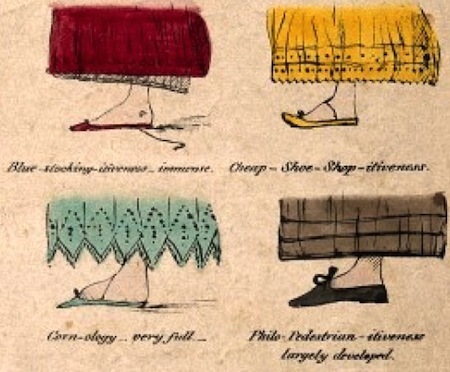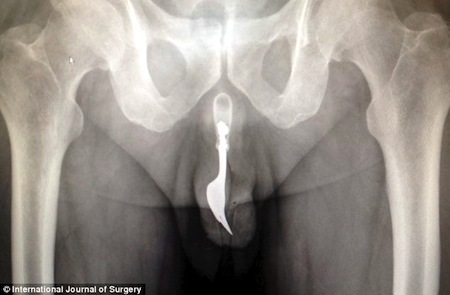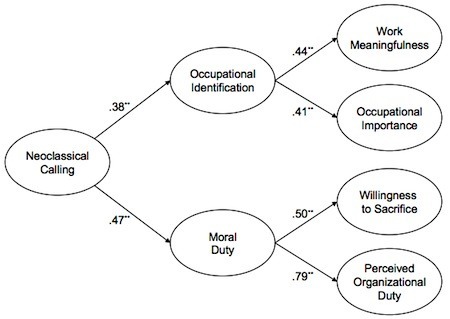Marc Abrahams's Blog, page 469
August 24, 2013
Robotic Doorknob Disinfector
Doorknobs and microbes are the joint area of interest of this report:
“Robotic Doorknob Disinfector,” Matthew Scott Rosoff, Department of Electrical and Computer Engineering, Cornell University, Ithaca, New York.
“The robotic door-handle disinfector is a robotic platform that travels heavily trafficked hallways and disinfects door-handles to improve public health. Machine learning algorithms were created to help the Erratic™ robotic platform navigate hallways and identify door-handles using only a commercial webcam and a laser scanner. A parts-based and a texture-based machine learning object detector were tested in a real-world environment. With the addition of a wall-aligning motion control algorithm, the partsbased object detector consistently detected >85% of the doorknobs in the environment and false-alarmed in

BONUS: The String and the Doorknob

The String and the Doorknob
If you are a dentist, or have ever met one, hark back with us to the days of yesteryear, as recounted in this treatise:
“The String and the Doorknob: Profile of a Popular Approach to Dental Extraction,” Eric K. Curtis, Journal of Oral and Maxillofacial Surgery, vol. 48, 1990, pp. 1084-1092.
In the writeup, details are sketchy, yet legion:
There are many variations of the string extraction motif reflected in popular art. They run a full spectrum, from pictures of a simple tug, to fantasies of the tooth-bound cord attached to a rocket blasting off.
One of the most common depictions involves tying the string to a doorknob, then heaving the door shut. Among the more dramatic versions is a drawing in which the twine is knotted to the caboose of a departing train. Another representation shows a dog as energy source for a tooth’s dislodging. A purportedly true story describes the technique of Dr Messenger Monsey (1693 to 1788), a famous medical eccentric. Monsey lashed a tough length of catgut around his own tooth to be extracted. At the other end he connected a bullet. He next loaded a pistol with the ball and a full measure of powder and fired the gun….
Tooth removal with string is a simple and vivid concept. String extraction graphically enhances the drama of, even symbolizes, the “pulling” of a tooth. Indeed, its continuing popular esteem may lie in its usefulness as a metaphor for all extraction. No training is required. The method is noninvasive; no needles or forceps are involved. The patient and practitioner alike can distance themselves, psychologically and physically, from something potentially unpleasant….
An Egyptian dentist was once reputed to have the ability to remove teeth with a common skeleton key and a piece of twine “with great dexterity and rapidity.“ If such effortless uprooting is possible, why resort to anything more frightening or complicated?

August 23, 2013
The classic shoot-the-monkey demonstration, anew
Daniel Rosenberg (whom you will see in the Ig Nobel Prize ceremony next month) and his colleagues at the Harvard Science Center staged and shot (anew!) this brief video of a classic physics demo:
This is a demonstration of the independence of the horizontal and vertical components of the velocity of a projectile. Often referred to as “the monkey and hunter,” the problem is the following. Suppose a hunter (at ground level) points a gun directly at a monkey hanging from a branch high in a tree. The monkey, being very intelligent, does not want to be shot. It knows that light travels faster than bullets and reasons that, if it lets go of the branch the instant it sees the gun being fired, it will fall down far enough before the bullet reaches its destination and thus miss its mark. What happens? Unhappily the monkey does not know that the gravitational acceleration is the same for all falling objects (whether they be bullets or monkeys) and thus the bullet falls the same distance as the monkey, hitting it on the way down. Neither the bullet’s initial velocity nor the distance between hunter and monkey is relevant to the final outcome, and affects only the height above the ground where bullet meets monkey….

The, or Some, Ethics of Topiary
If you’re an appreciator of cutting-edge topiary why not check out the Mosaïcultures internationales® exhibition in Montréal, Canada, which features around 50 works created by horticulturist-artists from 25 countries, and runs until September 29, 2013. You’ll find plants, bushes and trees clipped, snipped and cajoled into frogs, sheep, and Madagascan ring tail lemurs.
But might some phytosculptural appreciators experience a sense of uneasiness? Perhaps they could see topiary as a manipulation or even a contortion of natural processes? And find themselves wondering what, if any, are the ethical concerns of topiary? For one of the very few academic discussions around this subject turn to the journal Ethics & the Environment, Volume 8, Number 1, Spring 2003, pp. 127-142, where Dr. Isis Brook, and Dr. Emily Brady present their paper ; ‘Topiary: Ethics and Aesthetics’
“In this paper we discuss ethical and aesthetic questions in relation to the gardening practice of topiary. We begin by considering the ethical concerns arising from the uneasiness some appreciators might feel when experiencing topiary as a manipulation or contortion of natural processes. We then turn to ways in which topiary might cause an ‘aesthetic affront’ through the humanizing effects of sentimentality and falsification of nature (most often found in representational rather than abstract topiary). Our contention is that successful topiary emerges through a dynamic and positive relationship between topiarist and tree, where the gardener works with nature’s forms instead of in strong opposition to them. Appreciation of successful topiary, we shall argue, is marked by an experience of both the tree as a living thing and the artifice which has shaped it.”

August 22, 2013
Victorian body parts, in London, in September
The Victorian Body Parts conference happens at Barts Pathology Museum, West Smithfield, London, on September 14. To book a place, use the Victorian Body Parts booking form. “The conference is being organised by Beatrice Bazell and Emma Curry, both in their 2nd year of PhD research at Birkbeck, working on representations of body parts in Victorian culture.)”
The day is planned to have the following, er, parts:
09.50-10.00 Opening Remarks
10.00-11.15 Keynote Panel
11.45-13.00 Panel One: Severed Parts
13.45-15.00 Panel Two: Prosthetic Parts
15.15-16.30 Panel Three: Gendered Parts
16.45-17.30 Keynote Address
17.30-17.45 Closing Remarks
A pdf programme can be downloaded here: Victorian Body Parts Programme
(Thanks to investigator Ivan Oransky for bringing this to our attention.)
BONUS: Baby teeth

August 21, 2013
Perfecting the ‘mimicat’
“Today a character costume can be seen in many places, such as amusement facilities, sport stadium and so on. They perform comical and funny body action for us. In general, the performers can’t control their costume’s facial expression. We developed ‘mimicat’ that can synchronizing performer’s facial action and costume’s one. A character costume performer can do more comical action by using mimicat. At first our motivation is combining animatronics and face and expression recognition.”
Researchers Rika Shoji, Toshiki Yoshiike, Yuya Kikukawa, Tadahiro Nishikawa, Taigetsu Saori, Suketomo Ayaka, Tetsuaki Baba, and Kumiko Kushiyama of the Graduate School of System Design, Tokyo Metropolitan University, Tokyo, Japan, presented their project ‘mimicat : Face input interface supporting animatronics costume performer`s facial expression.’ at SIGGRAPH 2012, Los Angeles, California, August 5 – 9, 2012.

Click the cat’s head, or here to read the paper in full
Although the mimicat adequately fulfilled requirements in the costume support action synchronization arena, the research team have already identified possible improvement strategies :
“On the other hand our actuators are relatively too few and simple.
So for the future work we will install other actuators and try to
express more minute facial expression, such as an air actuator to
express the puff of user’s cheek.”

August 20, 2013
A fork in the rod [medical case report]
Some persons use a fork to eat dinner. At least one person found an alternate use for the implement:
“Urethral Foreign Body,” Krishanth Naidu, Amanda Chung, and Maurice Mulcahy, International Journal of Surgery Case Reports, 2013. The authors, at the Canberra Hospital, Canberra, Australia, report:
“Lower urinary tract foreign body insertions have a low incidence. The motives for insertion of a variety of objects are difficult to comprehend. This case warrants discussion given the great management challenge faced by the oddity and infrequency with which a fork is encountered in the penile urethra…. A 70-year-old man presents to the Emergency Department with a bleeding urethral meatus following self-insertion of a fork into the urethra to achieve sexual gratification. Multiple retrieval methods were contemplated with success achieved via forceps traction and copious lubrication…
“If one reviews current literature, it is apparent that the human mind is uninhibited let alone creative. The wide array of self-inserted foreign bodies include needles, pencils, ball point pens, pen lids, garden wire, copper wire, speaker wire, safety pins, Allen keys, wire-like objects (telephone cables, rubber tubes, feeding tubes, straws, string), toothbrushes, household batteries, light bulbs, marbles, cotton tip swabs, plastic cups, thermomethers, plants and vegetables (carrot, cucumber, beans, hay, bamboo sticks, grass leaves), parts of animals (leeches, squirrel tail, snakes, bones), toys, pieces of latex gloves, blue tack, Intrauterine Contraceptive Devices (IUCD), tampons, pessaries, powders (cocaine), fluids (glue, hot wax).”
Detail from the study:
(Thanks to investigator Sharon Trudgeon, the Canberra Times, and the Daily Mail, for bringing this to our attention.)

If you’re in Paris or Atlanta on Ig Nobel night…
If you’re in Paris on Ig Nobel night (Thursday, September 12), come to L’Espace des sciences Pierre-Gilles de Gennes:
Soirée IgNobelJeudi 12 Septembre, de 21h30 à 2h00 en connexion directe avec Harvard pour la 23e cérémonie officielle des IgNobel Prizes.
La 23e cérémonie des IgNobel Prizes approche à grand pas… Venez vivre l’événement comme si vous y étiez, lors d’une soirée résolument déjantée !
Physique des spaghettis, jeux du vrai-faux IgNobel prize, cabaret d’improvisation théâtrale… La cérémonie de 2012 était riche en surprises et rebondissements. Mais que nous réserve l’édition 2013 ? Plus d’infos très bientôt…
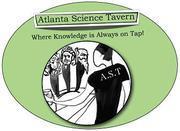 If you are in Atlanta, Georgia, that night, come watch at the party there Atlanta Ig Nobel Prize Ceremony Watch Party.
If you are in Atlanta, Georgia, that night, come watch at the party there Atlanta Ig Nobel Prize Ceremony Watch Party.
If you are in Cambridge, Massachusetts, of course, come be at the actual Ig Nobel Prize ceremony (but get TICKETS first, if there are any left!)
And if you can’t come to one of the public gatherings, gather a few watch the live webcast!
ELSEWHERE: If you are elsewhere, and want to organize your own Ig webcast-watching party, please let us know so we can help spread the word.
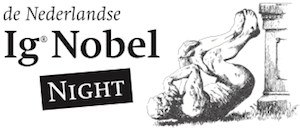 BONUS: On Saturday night, September 14—two nights after the ceremony— there’ s a giant Ig Nobel celebration in Leiden, the Netherlands: Der Nederlandse Ig Nobel Night.
BONUS: On Saturday night, September 14—two nights after the ceremony— there’ s a giant Ig Nobel celebration in Leiden, the Netherlands: Der Nederlandse Ig Nobel Night.

August 19, 2013
On realizing you’re wrong: Buzz about bees
Scicurious wrote a nice essay, a while back, about realizing you’ve been wrong:
So I posted something the other day on bees and cell phones. The science in the paper itself wasn’t convincing to me, but the other references they pulled out in the discussion made me pull an about face. I thought, hey, maybe the electromagnetic field potentials from the cell phones ARE contributing to colony collapse disorder.
And thus I wrote my post.
And then came the morning, and Jonathan, on Twitter, who pointed out I was wrong (Credit to him and all the people at Ars Technica, for not only doing good writing, but for including links to papers at the end!!! WOO!!). And I looked, and asked, and then asked around.
I am TOTALLY F***ING WRONG, YOU GUYS.
I hate being wrong. I feel really dumb, and I feel like I’ve let you all down (all two of you who read the blog). I’m sorry, you guys.
SO. Like the good little scientist, I am going to revise my hypothesis. We’re going to cover this paper again, with MOAR references, and MOAR research. And I’m going to get it RIGHT. Or as right as I can under the circumstances.
Favre, D. “Mobile phone-induced honeybee worker piping” Apidologie, 2011….

The Dialectic of the Calling of the Zookeeper
Why, zookeeper? And or maybe: Why zookeeper? Both questions get some wrestling with in this study:
“Call of the Wild: Zookeepers, Callings, and the Dual Edges of Meaningful Work,” [pictured here] and Jefferey A. Thompson, to be published in Administrative Science Quarterly. (Thanks to investigator Eden Hemming for bringing this to our attention.) The authors, at Washington University in St. Louis and Brigham Young University, explain:
“Our in-depth examination of work meaning within the zookeeping profession pointed to the centrality of the notion of work as a personal calling. The view of calling expressed by zookeepers, however, was closer in basic structure to the classical conceptualization of the Protestant reformers than it was to more recent formulations. We explore the implications of this neoclassical conceptualization of calling for the relationship between individuals and their work. We find that a neoclassical calling is both binding and ennobling, both a source of identification, meaning, and significance as well as a source of duty, sacrifice, and vigilance. Hypotheses suggested by this emergent theoretical model were supported in a sample of zookeepers from 157 different zoos.”
Here’s detail from the study:
The authors make a special effort to say: “The paper also benefited from developmental feedback provided by participants at seminars with several groups [, including] the May Meaning Meeting of the Center for Positive Organizational Scholarship“.
BONUS (possibly related): A (possibly) different dialectic:

Marc Abrahams's Blog
- Marc Abrahams's profile
- 14 followers



